Folklore had it that many important temple patrons had tried to set things right about these temples but failed - which made the mission even more challenging.
On the way Plastics Chandra pointed out to a dilapidated temple which he claimed he saw everytime on this route. What was new even to him was that there were a couple of earth-movers and the area surrounding the temple looked cleaned-up and inviting.

On enquiring, the priest there, said that the villagers had come together to re-build the temple. They were planning to demolish the existing structure and start building a new temple. Chandra almost screamed hearing this. We took the priest and a local villager around the temple, trying to explain to them why they cannot build an exquisite structure as that brick-built temple, in its present glory.
We took leave, after promising them that we would visit them again with Dr. T. Sathyamurthy, archeologist, to guide them as to how to preserve the old structure.
After breakfast at an Udupi hotel in Gummidipoondi, we entered pudhugummidipoondi and almost instantly located the paleeshwarar temple.
The Raja gopuram was in ruins, but through the hole in the huge wooden door, we could see a moderately well-maintained garden.

Later in the evening, when we went back, and forced a localite to ask the priest to come to open the temple for us, I was in for a (rude) shock when I saw the first hindu priest with a moustache, offering a visiting card for his astrology sessions.
Shock after shock. The priest was somehow able to get some money for renovation of the temple. The flooring of the inner-temple was marble, while the gopurams and rajagopuram were almost forested.
The carvings on the (what in our estimate was 400-800 year old temple) pillars were un-artistically painted with acrylic paint (a definite no-no, if you ask any acheologist worth his salt - or so says plasticschandra). The best example is a hanuman painted green with his tail painted in black. Am guessing they let a 6 year old kid practise his painting skills on the pillars.
Chandra, always the 'signs' guy now spotted a sign. A bearded old man (sanyasi?) who claimed to be a kali-upasakar. He was vague about where he came from and where he was headed. Like as if he were a wanderer, but was instructed by amman to be there on that day. He advised that whoever takes up renovation of the temple had to offer one goat, one pig and one chicken as sacrifice, because the temple was a kali-held temple, and the kali had to be pacified first.
Ramadoss and Senthil also scouted for how we could help the village. They went around talking to the village kids and parents about schooling facilities and what samarpanam could do to help the village.
A localite Mr. Chandrasekaran, came enquiringly, and took us to the village head, Mr.Selvaraj. Mr. Selvaraj was very hospitable and offered all help in getting the temples back to glory. We promised to return on the 16th of July with at least 50 people to clean up the temple. Mr. Selvaraj promised another fifty people and food for us.
We then visited the Chandrasekareswarar temple. This was another 400-800 year old temple, with no-gopuram style architecture. We noticed that some group had tried getting the temple back to shape in 2004, they had painted verses from tamil texts on the walls. But there was a lot of out-growth surrounding the temple. We were surprised that the priest was absent.
In the end of the narrow lane (which we guessed would have been the mada veedhi in the glory days of the temple), there was an old mandap - dilapidated and uncared for.

After surveying the compound, we decided that this would be one temple that really needed work. On coming out to of the temple, we ran into the priest at his home. I was surprised he wasn't willing to come out and perform pooja for the sake of us who visited the temple. But soon, I was to realize that this man was the father of the hairy-astrologer priest at the paleeshwarar temple, and that helped me understand the situation there vaguely (Little was I to realize what the graveness of the situation - all that in a later issue of the gummidipoondi files). The priest claimed that he had written many times to
the government officials, but HRCE was not helpful. The government had not paid him salary for this temple since 1995 and salary for the paleeshwarar temple since 1993. The government also did not provide for things necessary for pooja like oil, clothes and flowers.

We left pudhu gummidipoondi with a heavy heart, but confident of what we did that day and what work was pending. We had come at a time when the village head and the priests seemed cooperative and willing to do something about the temple. As a first step, we needed to gather 50-100 people to work on the outgrowths of the Chandrasekareshwarar temple. Later we need to sit with Mr. Selvaraj and the priests, as to how the local villagers can help support the temple's revival.
We seemed to have gotten a head-start in a task, temple and place not dared by many.









